2019 Honda HR-V Review and Buying Guide | A lot in a little package
https://ift.tt/2y6KERI
The 2019 Honda HR-V is one of the most space-efficient SUVs, managing to provide far more passenger and cargo space than you’d think possible from its diminutive exterior dimensions. If getting the most out of the least is important to you, the HR-V is going to make a lot of sense. It also boasts a reasonable price given that size plus a high-quality interior, ample feature content (especially the EX trim) and Honda’s legendary reliability. Even its crash scores were improved for 2019 along with a number of other elements described below.
The HR-V has a lot going for it, but it’s certainly not a slam dunk. Acceleration is among the slowest in the segment, and you don’t need a stopwatch to notice. Its all-wheel-drive system isn’t particularly sophisticated and isn’t a great choice if you’ll be dealing with deep snow or mud. Taller drivers are also unlikely to be comfortable in the driver seat, which has insufficient travel in all but the top Touring trim. As such, we’d recommend also considering the Subaru Crosstrek, Hyundai Kona or even the Kia Niro Hybrid.
What’s new for 2019?
The HR-V gets its first significant update this year. The styling has been tweaked, but it’s minor. New Sport and Touring trim levels debut, bringing with them distinctive styling and noteworthy features (the Touring includes a sorely needed power driver seat). The top three trim levels now come standard with the Honda Sensing suite of accident avoidance technologies, which were previously unavailable on the HR-V. IIHS crash scores have also improved.
As in other updated 2019 Hondas, the touchscreen interface gets a volume knob and some other updates. In terms of the oily bits, you can no longer get the HR-V with a manual transmission, which no one should be particularly concerned about. Happily, the CVT has apparently been retuned to be more refined than before.
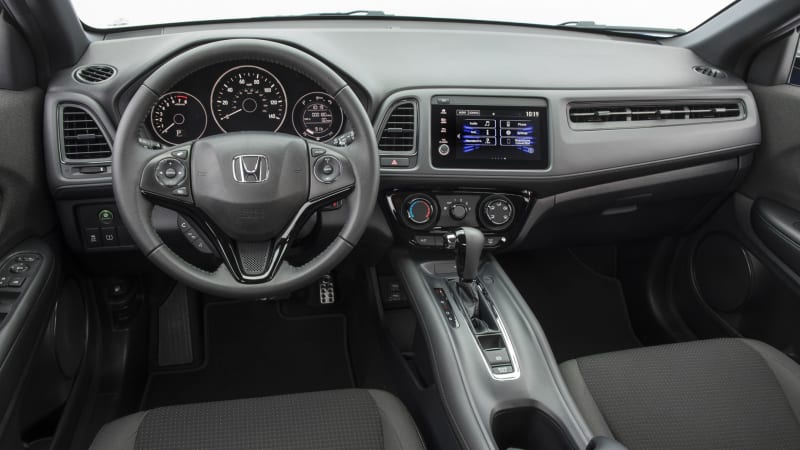
What’s the HR-V’s interior and in-car technology like?
The HR-V’s cabin is distinctive in the Honda SUV family as it skews a little more toward form than function. The rising “floating” center console that can be wrapped in padded simulated leather looks great, as do the unique touch-operated climate controls. Materials quality is excellent for this budget segment, and in general, we think this one of the more attractive and well-made interiors in the segment.
The same cannot be said for its infotainment system. Sure, Honda added a volume knob to the available touchscreen for 2019, but that omission wasn’t the system’s only flaw. It’s still a bit slow, and the menu structure convoluted. You only need to look inside an Accord to see what Honda infotainment is capable of. Along with that touchscreen, all but the base LX trim come with two USB ports (inconveniently located under that floating center console), Apple CarPlay, Android Auto and a variety of smartphone apps through HondaLink.
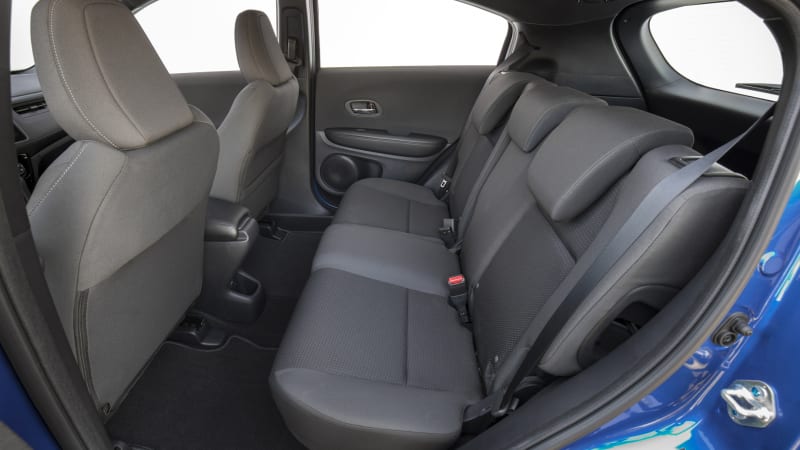
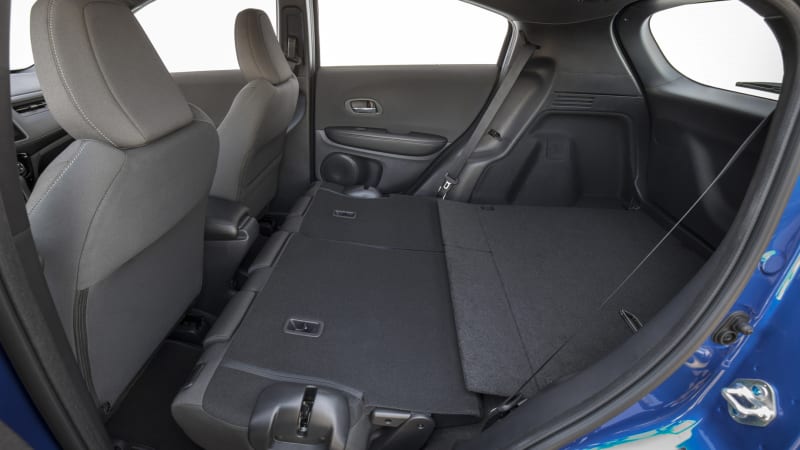
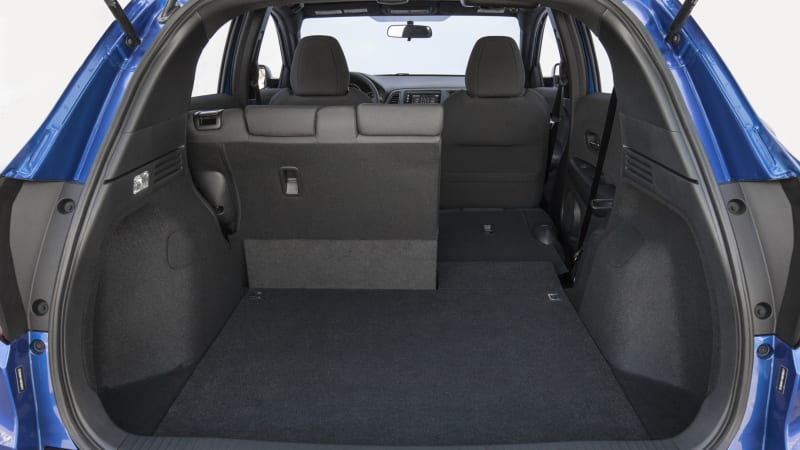
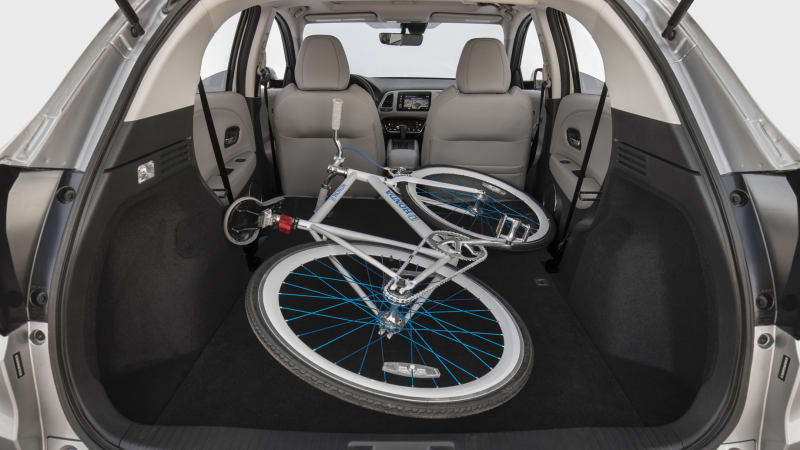
How big is the HR-V?
If you’re looking for a sub-compact SUV (or at least an inexpensive SUV) with the most interior space possible, it’s hard to beat the HR-V.
It features the same “Magic Seat” as the Honda Fit – with the gas tank under the front seat, the back seat can fold completely flat into the super-low floor – affording it unmatched space and versatility. There’s a best-in-class 24.3 cubic-feet with the seats raised (FWD) and 57.6 cubic-feet with them lowered. Only the Nissan Kicks comes remotely close to that. The Magic Seat’s 60/40-split bottom also flips up, allowing you to store things across an ultra-long rear footwell.
Up front, those of above-average height will struggle to get comfortable behind the wheel due to a driver seat that doesn’t slide far enough back or dip far enough down. There is thankfully an eight-way power driver seat available for 2019 that should at least partially rectify this, but it’s exclusive to the top trip level.
Outside, the HR-V is 169.1 inches long, which is pretty much mid-pack for the segment, falling in between the bigger Subaru Crosstrek and smaller Hyundai Kona. Its 63.2-inch height is typical for the segment, and its ground clearance is modest at 7.3 inches with front-wheel drive and 6.7 inches with all-wheel drive. That’s actually as good or better than many competitors, but also not well suited to actually venturing off the beaten path (its unsophisticated all-wheel-drive system doesn’t help on that front, either).

What’s the HR-V’s performance and fuel economy?
The situation under the HR-V’s hood is pretty simple. Every version comes with a 1.8-liter inline-four that produces 141 horsepower and 127 pound-feet of torque, one of the lowest outputs in the segment. Front-wheel drive and a continuously variable transmission (CVT) are standard, while all-wheel drive is an option.
The front-drive HR-V returns an estimated 28 mpg city, 34 mph highway and 30 mpg combined, making it one of the thriftiest in the segment. All-wheel drive lowers those estimates to 26/31/28 in most trim levels with the LX basically getting 1 mpg better.
What’s the HR-V like to drive?
The HR-V is very slow. Honda says it improved the sluggish responses of the CVT for 2019, and although we haven’t yet sampled this change, we doubt it’ll do much to help one of the weakest engines in the segment. This is a shame, since Honda has much better engines at its disposal.
It’s also a shame since the HR-V is otherwise a competent little SUV to drive. Corners are taken with relative poise and the steering is precise. Meanwhile, ride comfort is better than most as are wind and road noise.
What more can I read about the Honda HR-V?
Our breakdown of what’s new for the 2019 Honda HR-V.
What features are available and what’s the HR-V’s price?
Pricing for the 2019 HR-V starts at $20,620, including the $1,065 destination charge. All of the following prices are for front-wheel-drive models. All-wheel drive adds $1,400.
The base LX is sparsely equipped with standard 17-inch alloy wheels, the “Magic” back seat, cloth upholstery, and a four-speaker sound system that includes a CD player, a USB port, a media player interface and a faceplate with a large display, buttons and knobs.
From there, HR-V pricing remains quite reasonable, as the Sport ($22,320) and EX ($23,830) add a considerable amount of extra equipment for really not that much money. That includes Honda’s 7-inch touchscreen with Apple CarPlay and Android Auto. We would recommend going with the EX, though. It doesn’t have the snazzy gloss-black exterior trim pieces or a leather wrapped steering wheel, but it’s the first HR-V to get the Honda Sensing suite of accident avoidance tech (see safety section below) plus a variety of other niceties.
The EX-L ($25,320) and Touring ($28,540) don’t add a wealth of equipment, but they still come in under the range-topping versions of many competitors, which can cross the $30,000 threshold.
You can see a full breakdown of features, specs and local pricing here on Autoblog.
What are the HR-V’s safety equipment and crash ratings?
The HR-V LX and Sport come with the usual assortment of airbags and stability control, but accident avoidance tech doesn’t come standard until the EX. That, plus the EX-L and Touring, get forward collision warning, automatic emergency braking, lane-keeping assist, and Honda’s LaneWatch blind-spot warning camera.
In government crash tests, the HR-V receives five out of five stars for overall and side protection, plus a four-star rating for frontal protection. The 2019 model also improved dramatically from last year’s version in testing by the Insurance Institute for Highway Safety. It’s now a Top Safety Pick due to improved small overlap front scores as well as the newly available Honda Sensing features.
Auto Blog
via Autoblog https://ift.tt/1afPJWx
July 23, 2019 at 10:36AM
